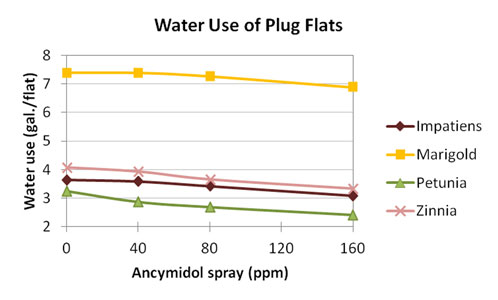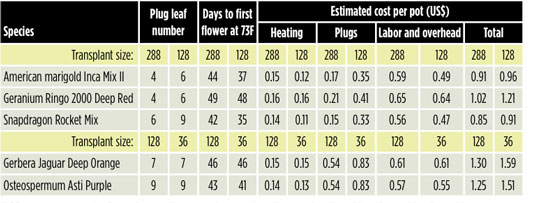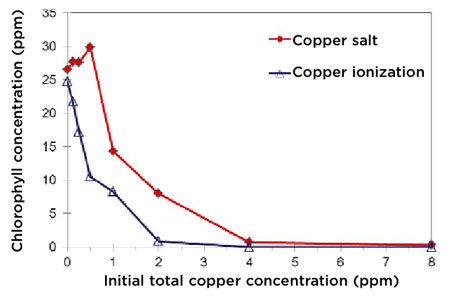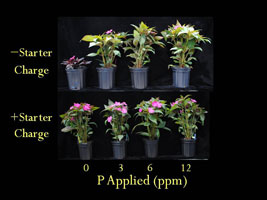8/27/2012
The Latest on Plug Production
The Floriculture Research Alliance

The Floriculture Research Alliance includes researchers who collaborate across universities and organizations on applied research. Their mission is to partner with industry stakeholders to develop science-based solutions to sustainability issues for floriculture. The universities collaborate with the USDA-ARS and are supported by the USDA Floriculture and Nursery Research Initiative. For more information, visit www.floriculturealliance.org.

Table 1. An example of estimated production costs when starting with two plug sizes (36-, 128-, or 288-cell trays) in the production of five bedding plant species grown at 73F (22C) for first flowering on April 1. Heating costs were calculated using Virtual Grower software for Grand Rapids, Michigan. Production time was based on research information generated in this project.
Seedling Plug Size Effects on Flowering Time
By Tasneem Vaid and Erik Runkle, Michigan State University
One of the factors that influences finish crop time of bedding plants is the maturity or starting size of the plugs or liners. A general assumption is that time from transplant to flowering is shorter when starting from a large plug compared to a smaller one, although limited research-based data is available. We evaluated the effect of two plug sizes on finish crop time, plant quality characteristics and estimated production costs in five bedding plant species.
Among the species evaluated, plants grown as 128-cell plugs were more mature (had more leaves) and therefore flowered earlier than those grown from 288-cell plugs (Table 1). For example, snapdragon plants grown from a 128-cell plug had three more leaves at transplant and flowered seven days earlier at 73F (22C) than those grown from a 288-cell plug. In contrast, gerbera and osteospermum grown from 128- and 36-cell plugs were similar in maturity and—not surprisingly—flowered at the same time. Plug size had little or no effect on plant quality characteristics at first flowering.
As an example, we performed a simple economic analysis for the two plug sizes in this study using typical input costs. Our analysis showed that plants grown from a smaller plug had the lowest input costs, and therefore, a greater potential profit per pot (Table 1). Although some larger plugs flowered earlier, the shorter finish time was often offset by the higher price of the larger plug. Therefore, starting with a larger plug may not be a profitable strategy. Growers are encouraged to perform a more detailed analysis, using their own costs (heating costs can be estimated using Virtual Grower), to determine which plug size is the most appropriate and cost effective for their situation.
 Table 2: Plant growth regulators reduce water use of seed and cutting-propagated plugs.
Plant growth regulators reduce water use
By Iftikhar Ahmad, Brian Whipker & John Dole, North Carolina State University
Table 2: Plant growth regulators reduce water use of seed and cutting-propagated plugs.
Plant growth regulators reduce water use
By Iftikhar Ahmad, Brian Whipker & John Dole, North Carolina State University
The effectiveness of plant growth regulators is well known; however, growth regulators have a number of other effects on plants, including reducing water use, darkening of the foliage and improved postharvest performance. At North Carolina State University, we’re studying these secondary effects and determining their economic benefits for plant producers and shippers. Specifically, it’s been documented that plant growth regulators reduce water use; however, little information is available that tells us how much water is saved. We grew and monitored the total amount of water used for two potted bedding plant crops: Pacino Gold sunflower (5-in. pots) and Magellan Pink zinnia (4.5-in. pots). And four plug crops in 128-cell flats: Moonsong Deep Orange marigold and Magellan Pink zinnia (grown from seed); Fiesta Burgundy impatiens and Suncatcher Coral Prism petunia (grown from vegetative cuttings).
As the plant growth regulator concentration increased, plant growth (fresh weight, dry weight, plant height and diameter) and total water use was less for all tested species. For potted sunflowers, a 1.0 to 2.0 ppm drench of paclobutrazol resulted in the lowest water used—24% less water use at 1.0 ppm and 32% less water at 2.0 ppm compared to control. For potted zinnia, a 0.5 to 1.0 ppm paclobutrazol drench decreased water use by 33% and 45% at 0.5 and 1.0 ppm, respectively. For plugs, the optimal concentration of ancymidol was a foliar spray application of 80 to 160 ppm, as these concentrations reduced water use by 6 to 15% for impatiens, 1 to 7% for marigold, 17 to 25% for petunia, and 10 to 18% for zinnia.
In summary, application of plant growth regulators not only controls excessive plant growth, but also reduces water use. Producers can consider the water-use reduction from using PGRs in addition to the traditional benefit of growth control as a best management practice.
 Table 3. Effect of copper form (ionization from electrolysis or a nitrate salt) and concentration (0 to 8 ppm) on algae concentration (as measured by chlorophyll concentration) in a nutrient solution.
Water Quality Research
By Paul Fisher, University of Florida
Table 3. Effect of copper form (ionization from electrolysis or a nitrate salt) and concentration (0 to 8 ppm) on algae concentration (as measured by chlorophyll concentration) in a nutrient solution.
Water Quality Research
By Paul Fisher, University of Florida
The humid and warm environment in young plant production results in water-quality issues such as root diseases and algae. Industry partners in the Floriculture Research Alliance identified a research priority to evaluate the cost, practicality and efficacy of different sanitizing agents such as activated peroxygens, chlorine, chlorine dioxide, copper ionization and ozone for control of pathogens, algae and biofilm.
One project by graduate student Rosa Raudales collected published plant pathology research on efficacy of sanitizing agents in irrigation water. The result is an online grower tool called “Waterborne Solutions” that you can search by pathogen or treatment technology. Go to our website—
www.watereducationalliance.org—click on the “Grower Tools” tab and then “Waterborne Solutions.” You can easily look up, for example, test results for efficacy of chlorine to control Pythium, where research showed a high level of control of zoospores at 2 mg/L of free chlorine at a water pH below 7.5.
Another project by technician Gavin Mohammad-Pour quantified the efficacy of copper for inhibiting algae and microbial growth in nutrient solutions. Vessels contained a blend of sub-irrigation solution used in sub-irrigation of young plants at a Florida nursery, and additional nutrients at 100 ppm N from a 17-4-17 Greencare water soluble fertilizer. To those solutions, we added from 0 to 8 ppm of copper from either Copper ionization (via electrolysis) or a copper salt (copper nitrate).
After 16 days of incubation in a greenhouse environment, vessels containing 0 to 0.25 ppm Cu from copper nitrate showed similar increases in chlorophyll and biomass, after which algae content decreased to near zero at 4 ppm Cu (Table 3). Yeast and mold density followed similar trends with a 99.9% drop at 2 ppm Cu and the colony count was near zero at 4 ppm Cu. However, aerobic bacteria count (an indicator of potential equipment clogging from biofilm) was resistant to all Cu levels from both copper forms, and remained at a very high level.
Copper ionization was more effective at a given ppm Cu than copper nitrate at controlling algae and fungi. Subsequent research showed that Cu from copper ionization was more soluble at high pH than Cu from a copper salt. Because pH varies during the day/night cycles in sub-irrigation tanks and ponds, the pH response of the copper forms were likely to be important. For the full report, visit
www.floriculturealliance.org under “Grower Resources.”
 Table 4: Compact Lilac SunPatiens grown without starter charge (top row) or with starter charge (1 lb. 20-10-20/cubic yard of media) incorporated into the grown media prior to transplant. The plants received the same concentration of all nutrients in a constant liquid fertilization program with the exception of phosphorus, which was applied at the rates of 0, 3, 6 or 12 ppm (left to right). Photos were taken nine weeks after sticking the cuttings in propagation. Plants were in propagation for two weeks prior to transplant.
Table 4: Compact Lilac SunPatiens grown without starter charge (top row) or with starter charge (1 lb. 20-10-20/cubic yard of media) incorporated into the grown media prior to transplant. The plants received the same concentration of all nutrients in a constant liquid fertilization program with the exception of phosphorus, which was applied at the rates of 0, 3, 6 or 12 ppm (left to right). Photos were taken nine weeks after sticking the cuttings in propagation. Plants were in propagation for two weeks prior to transplant.
Examining the Potential for Using Phosphorus Restriction as a Height-Control Technique for SunPatiens
By James E. Faust & Allison Justice, Clemson University
Stem elongation is impacted by the amount of phosphorus delivered to a crop. Paul Nelson at North Carolina State University demonstrated that high rates of phosphorus can cause undesirable stretch in seedlings. These results suggest that restricting the amount of phosphorus applied can possibly reduce stem elongation and, thus, act like a plant growth regulator.
We conducted a series of experiments to determine if low rates of phosphorus could help control stem elongation of relatively rapid elongating SunPatiens. In these experiments, we started with growing media that had a standard starter charge (1 lb. 20-10-20 per cubic yard of media) or had no starter charge. Plants were then irrigated with fertilizer solutions containing normal levels of all the essential nutrients except phosphorus, which was added at the rate of 0, 3, 6 or 12 ppm.
The starter charge in the growing media provided enough phosphorus to produce a healthy finished crop even when no additional phosphorus was applied (Table 4). There was very little impact on plant height restriction amongst the plants receiving the starter charge. The plants that did not receive a starter charge exhibited phosphorus deficiency a few weeks after transplant when no phosphorus was applied in the liquid fertilization program. These plants were very short but also had completely purple leaves. The plants that received 3 ppm phosphorus were about 10 to 20% shorter than those plants receiving 6 to 12 ppm phosphorus. So, a very low rate of phosphorus was successful at reducing stem elongation. However, this could be difficult to manage in a commercial situation, since it can be difficult to accurately deliver such low rates.
The most unexpected result was that the plants receiving no starter charge flowered approximately one week later than those receiving a starter charge. This suggests that phosphorus needs to be supplied early in the crop cycle for flower initiation to proceed normally.
Our work suggests that the best strategy to reduce stem elongation with phosphorus deficiency would be to use a starter charge in the growing media at approximately half rate. This will ensure that enough phosphorus is available for normal flower initiation. Alternatively, the initial liquid fertilizer applied for the first couple of weeks after transplant should possess phosphorus. Then a very low rate of phosphorus (~3 ppm P) should be applied in the constant liquid fertilizer program. If any purple pigmentation is noticed in the foliage, then the phosphorus rate should be increased slightly.
The bottom line is that phosphorus restriction does work on SunPatiens, however, because so little phosphorus is really needed for good plant growth, it can be difficult to supply a concentration that is easily managed. For SunPatiens, water restriction is likely a more effective and more manageable approach. Our work also suggests that we’re likely applying much more phosphorus than is really required for healthy plant growth in many commercial situations.
GT